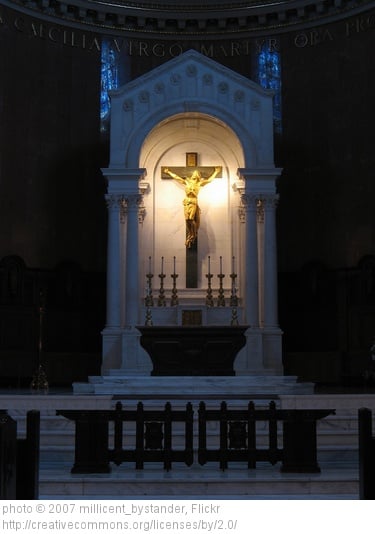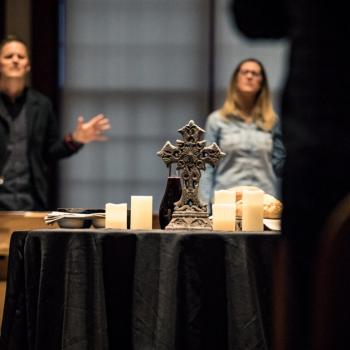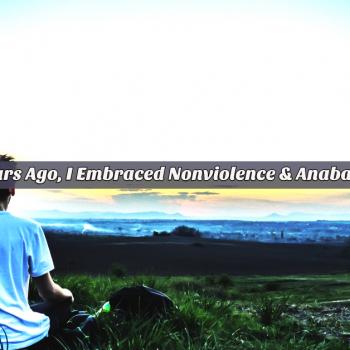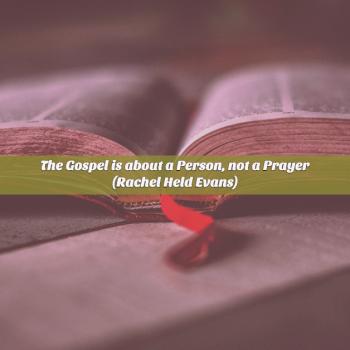I’m thrilled to tell you about a book that is out called From Willow Creek to Sacred Heart: Rekindling my love for Catholicism. Chris Haw, who you may remember as one of the authors of Jesus for President, tells of his journey from evangelicalism, into the New Monasticism, and ultimately into the Roman Catholic Church. If you read my article, “If I wasn’t Anabaptist, I’d probably become Anglican” or some of the guest posts on this site, you probably can guess that I have a generous and open posture toward my Catholic sisters and brothers.
But, you can also imagine why I would ask the first question below in a discussion with Chris. Do the big ideas in Jesus for President (which I read as a basic apologetic for Anabaptist views toward the state and violence) find themselves compatible with Roman Catholicism? Chris will give you some thoughts below. I then, give him some follow-up questions, somewhat with my readers in mind. I look forward to your thoughts!
PS – I have one free book to give away! To win: share this post on Twitter or Facebook and leave a comment with your name and valid email.
————————————————————————————
 KURT: Your book Jesus for President (written with Shane Claiborne) was decidedly a Hauerwasian affirmation of an Anabaptist-type politics. And now you’ve got a book regarding your joining the Catholic Church. Have your politics changed at all; or how to your Anabaptist convictions and Catholic worlds collide?
KURT: Your book Jesus for President (written with Shane Claiborne) was decidedly a Hauerwasian affirmation of an Anabaptist-type politics. And now you’ve got a book regarding your joining the Catholic Church. Have your politics changed at all; or how to your Anabaptist convictions and Catholic worlds collide?
CHRIS: This is one of my most exciting topics of thought and contemplation these days, and I’m glad you asked it. I think it among the most important questions for our theology these days–and by “our” I am referring to any one who has lived in the years following the birth and ascendancy of Mr’s Yoder and Hauerwas: their political theology is especially compelling in one massive way–if I can be so bold as to attempt a summary: that Christ cut us off from the world. By that, I (or they) mean, Christ’s foolishness cuts us off from political expediency and the calculations of warriors, strategists, and the Powers. We don’t have to play by the lesser–of–two–evils rules. Christ’s command to enter his kingdom keeps us from becoming custodians of Caesar’s. The Sermon on the Mount’s exceedingly powerful commands shatter our careful calculations about steering the course of history and making everything turn out ok. With Merton, we are no longer allowed to pray, “give us more time,” but we must return to Maranatha: “come quickly.” And this is why we have put down the sword since Gethsemene. This is about as blunt of a summary I can manage with them.
Now, the usual purveyors of this story usually go on to say that it took a few centuries to ruin this philosophy. And around the 4th century, as the Empire was teetering toward collapse, Constantine and Theodosius sucked Mother Church back into the pagan servitude of power. And since then we can only use fragments of the Big Nasty Church: we can draw upon the Creed, we can selectively draw upon the Councils, we can definitely draw on the Ante-Nicean Fathers and Mothers, and we can selectively draw upon the canon of saints–St. Francis usually being first place, with runners up being miles behind.
Stanley Hauerwas, it should be noted, is not very happy with this rendition of Church history that fancies itself at odds with “Tradition” while skipping back over two thousand years of history to the ostensible purity of the early Church. He calls this popular Protestant ecclesiology a “New Testament and Now” model, and denounces it. For you cannot critique the Tradition without using the Tradition, he insists. The Great Tradition has so formed us, has so permeated us, that we dare not use it while pretending not to use it–perhaps like the Modern disassociation from ecological-awareness, using the earth while not understanding we are using it up. He’s saying this also from a historical perspective: if you don’t learn from Church history you’ll probably confuse your latest fad innovation as being innovate; in all likelihood you are repeating a heresy that was reasonably denounced in the 4th or 8th century or something—like Donatism or Manicheanism.
KURT: I’M TRACKING WITH YOUR LOGIC HERE. I SHARE THIS CRITQUE, TO AN EXTENT, AS YOU KNOW FROM MY “ANGLICAN” ARTICLE. BUT, DO WE EVER HAVE PERMISSION TO PUSH AGAINST THE TRADITION, EVEN AS IT IS APPLIED IN THE MODERN EXPRESSION OF THE RCC? IT STILL SEEMS YOU WOULD HAVE TO. WHAT ABOUT THE ABILITY TO CHALLENGE AND PUSH AGAINST CANNONIZED THEOLOGY? DO WE LET THOSE IN POWER (THE POPE, ETC) DETERMINE WHAT THE SCRIPTURES “REALLY” MEAN?
CHRIS: Critiquing in detail the Roman Catholic Magesterium (or any other teaching “authority”) would be an exceedingly exciting and intellectual advance for critics. The current fad is to not read them, pretend to know their teachings, and then walk off in a huff. This is not critiquing; it is certainly not reforming. It is adolescent shoulder shrugging. So, if someone picked up some USCCB documents (written collectively by dozens of Catholic bishops), like The Challenge of Peace or Economic Justice for All, and then concluded that they feel insufficient or weak—as I have—I would heartily understand them and buy them a beer.
But, once the drinks arrived, I would also then ask them if they consider the insufficiency (and their own obvious theological superiority) worth maintaining a Church-split, or whether one might tolerate living among such worldly and moderate papists. If somebody insisted, after careful deliberation, they couldn’t, I would certainly respect him or her as a person of conscience. But if somebody really never cared or studied about the dispute, but were willing to maintain the feud in some vague sense, I would say they should give closer attention to their standards of Church unity.
Chesterton puts a good rejoinder to the plain anti-teaching-authority folks: “It is rational to attack the police; nay, it is glorious. But the modern critics of [religious] authority are like people who attack the police without ever having heard of burglary.” The theological equivalents of such burglary are numerous, and I’m glad there has been some office to denounce them: iconoclasts destroying art, Jansenists trying to destroy dramas, Donatists trying to destroy the stability of sacraments, Manicheans and Gnostics trying to destroy the body, Marcionists trying to destroy the Old Testament, Unitarians trying to destroy the Trinity, Luther trying to destroy pilgrimage sites, Zwingli trying to destroy singing, Strasburg trying to destroy the celebration of Mass, Henry trying to destroy the monasteries, Valentinus trying to destroy openness. And so on. Now, its obvious that in some of these cases, the Catholic Church responded in a way that was far harsher than we would ever hope today. But we are partly judging the 5th century (or others) by the 21st century; a strategy about as harsh as saying, “if we had lived in the time of the prophets, we would not have murdered them” (a claim which Jesus denounces as false pride, and harsh judgmentalism). We might remember that Protestants had the bad habit of persecuting their heretics. But on a lesser-known note of history, it should also surprise us to know that we have records in the middle ages of people on trial blaspheming (against, say, the Blessed Mother) so that they could be transferred to the ecclesial courts, which were known for being much more lenient and liberal. Imagine that!
I talked to somebody who, 20 years ago, attended a Catholic Church that had a few ridiculous members who showed the residues of racism and segregation. Apparently somebody even justified this theologically. Now, here is a wonderful thing about authority; we can’t just blather egalitarianism about how “the Catholic Church is simply, and only, all its baptized members.” No: it is immensely more encouraging to know that the Catholic teaching authority officially and definitively denounces such racism. And if it weren’t, we would know where to start arguing. Without some kind of identifiable impetus of teaching, we would constantly—on whatever topic—never know who or what this thing known as the Church means. We would conclude, upon meeting any random member, that this organization has nothing but crap to say for itself. Put another way, consider it a blessing that, in the magesterium, you at least know who to argue with if you have an argument. When some jerk down the pew spouts racist, imperialistic crap, you can proceed to tolerate him, ignore him, or convert him to the illustrious truth. But, if and when the magesterium spouts something you don’t like, you can proceed to get out your pen and paper, take notes, and then go sit in their office and argue with them the old fashioned way. But, in all, I’d like folks to reflect on how their “anti-hierarchicalism” fails to consider how there are plenty of things worth kicking out of the Church. That it should be done, there should be little disagreement; how to do it is the hard part. (And if someone declares that hierarchy is the thing to be kicked out, we might then ask, by who? By what method would such egalitarians police the appropriate levels of egalitarianism? Its tricky.)
KURT: AS AN EXAMPLE OF CRITIQUING THE TRADITION, WHAT OF JUST WAR? THE HISTORY OF CONSTANTIANISM HAS UNFORTUNATELY RESULTED IN THE CROSS AND THE SWORD GOING TOGETHER (ALTHOUGH, THIS IS TRUE OF CONSERVATIVE EVANGELICALISM AS WELL).
The Catholic teaching authorities have declared serious reservations about that standard, due to the heinous nature of modern warfare. For example, they declared the Iraq War unjust; and some of us might have wanted to see them excommunicate those who were going off to fight in the said injustice. But, keep in mind, that makes us toting a more conservative ecclesiology, not a more liberal one. This, to me, illustrates the liberal impasse with Church authority mentioned above; we like it when it defends and defines policies we want; but we categorically oppose it when it critiques something we like.
So, with the Just War tradition, my suggestion has been that while we should spend some time arguing about it (Ratzinger, 2003, posited that modern weaponry makes the question of just war virtually meaningless today), it is a much more difficult argument, actually, about ecclesiology: shall we, or shall we not, excommunicate parishoners who go off to fight in an unjust war? Why not start with that very tough question, at least? I would like my Mennonite friends join me in feel dirtied by playing out the logic of how to discipline a church into peaceableness.
I understand the abiding complaint of Constantinianism and warfare: It is exceedingly difficult to have a canon of saints that includes not only St. Francis, but Joan of Arc as well. I often wish she hadn’t been included. With my very little information on her, without asking about the relative merits of her warfare, success or legacy, I would eject Joan from the canon. I would reject her simply on Christ’s commands (or my Yoderian reading of his commands). But there’s something to a Faith that has enough room to include mostly saints like Francis AND a few rare warriors in it. It is a larger canon than I would have made myself; but at least for a moment, I can declare with a grand humility, that I am happy that I did not create my religion in my own image.
So, to return to your first question more explicitly: I have so far not yet regretted anything in Jesus for President on Catholic grounds. For Catholicism, as I see it, contains that type of foolish “eschatological” pacifism in the Francis’ of its canon. And yet, it allows for certain forms of defense–with criteria we are all too familiar with in the Just War model. We might say it believes in diversity too much to be only and irrevocably pacifist; and in Jesus for President, thank God, we never entirely closed the door to the more “worldly” forms of engagement in voting, governance, legislation. We allowed the voting question to remain open–while constantly pointing people to the alternative saintly ways of engagement and how voting can distract from the way we vote everyday. We allowed even participation in governance to remain open–again, while maintaining that there are plenty of ways to contribute to our world that are not even legislative or governmental. And while we certainly did read a Constantinian (or Theodosian) “Fall of the Church” into our history (for it is present in the history, in certain ways), we never allowed that conviction to turn into an excuse to leave the old mother Church behind or somehow excuse ourselves into being “mere” Christians, or nondenominational Christians–as our whole approach was incessantly historical and not abstract. While we never painted this tradition-preference with Catholic tones, we had a tone of refusing schism, of refusing to start a new “radical” church over and against the old one. We instead highlighted a path of refurbishing and participating in the crappy Church Peter handed down. That boundedness of the Body is a Catholic dogma that I heartily embrace and promote.
KURT:WHAT OF THE EXCLUSIVE MALE HIERARCHY RATHER THAN THE SEMI-STRUCTURED YET ORGANIC CHURCH WE SEE IN THE FIRST COUPLE HUNDRED YEARS OF THE CHURCH?
This indeed stands as a tension for me. I don’t see it as something, however, by which we would do well in citing the early Church. Sure, Janus in Romans appears to be a crack in the façade; various historical reports confirm substantial women’s leadership. But the first couple hundred years is not organic in any sense of hippie structurelessness. I don’t know where people keep getting this idea. The more I study it, the more I realize how structured it was. By the late first century and early second century it was declared wrong by people like Ignatius to celebrate Eucharist outside Episcopal oversight—and that’s more primordial than John’s gospel. Similarly, read Irenaeus or Clement. See the New Testament church filling the 12th seat of the apostles as though such a leadership symbol mattered; see them appointing (yes, not super consistently everywhere) episcopoi, diakonoi, prebyteroi. There was a profoundly structured network of bishops over 150 years before Constantine. Whether all this was a bunch of crap, offending our Lord and Savior, or not makes for plenty of good conversation, preferably over the aforementioned beer—and perhaps we can include good cheese (please); but it certainly makes me reconsider hailing for the “early Church” as some era of supremely organic form.
The complexity of the development of Church leadership makes me want dive into and thoroughly understand the history of the debate. That requires more patience, investment, and commitment than some folks have. But otherwise, I feel like I’m walking into the middle of a very deep and extended conversation to which I don’t understand the parameters and historical scope.
Personally, I am befuddled by the absence of women in the Congregation of the Doctrine of the Faith (CDF). As an entirely theological office, with apparently no symbolic or sacramental function, I am at a loss for their exclusion—and, while wanting to understand it more—am disappointed. But with their exclusion from the priesthood, this is, to me, a complicated discussion about what priests are. Unfortunately, in our day, priests have also taken on the role of administrator, secretary, pastor, etc; and so women’s exclusion is especially painful, as it excludes them from numerous important roles that I can see no reason for their exclusion. (I wonder if for pre-Vatican II folks this wasn’t as painful, particularly because there wasn’t such a temptation to veneration of the priest-as-rare-and-all-encompassing-person-at-large.) But the priest’s most substantial role is sacramentally acting, at Mass, the role of Christ at his Last Supper. And the “Second Adam” nature of Christ, paired with the “Second Eve” in the Church, is apparently essential, not accidental, to the symbolism. Most people’s eyes glaze over and check out at this point, not finding any substantial biblical (or otherwise, justification). I understand. It’s a tough sell; and perhaps the seeming failure will change things over time.
But I don’t understand how said critics can break communion on this issue based on a conviction for democracy: for what can it mean to have some smaller, liberal, often U.S.-based contingent of feminists (men and women), wish to overturn, in the name of their new post-1960s conviction, a long-held, globally-participated-in symbol? That actually seems quite undemocratic. At this point, I would simply urge my protesting friends (I indeed share their sympathies) to enter into the difficulty of democracy. So many of my liberal friends wax nostalgically about “native religion”; but the natives were more democratic than we enlightened by modernity; for they included their ancestors in the voting process. Catholic tradition, as Chesterton penned, is the democracy of the dead. And democracy is always disappointing for many participants. Catholicism is like being part of a global dysfunctional family, with weekly reunions.













